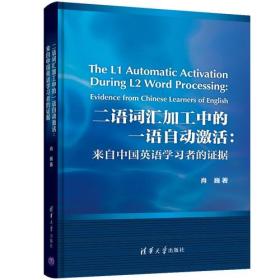
二语词汇加工中的一语自动激活:来自中国英语学习者的证据
全新正版 极速发货
¥ 41.23 5.3折 ¥ 78 全新
库存2件
作者肖巍
出版社清华大学出版社
ISBN9787302512684
出版时间2018-10
装帧精装
开本其他
定价78元
货号1201807773
上书时间2024-09-04
- 最新上架
商品详情
- 品相描述:全新
- 商品描述
-
目录
Preface
List of Abbreviations
Chapter One Introduction
Chapter Two Theoretical and Empirical Background
2.1 Definition of Key Terms
2.1.1 Bilinguals
2.1.2 Mental Lexicon
2.1.3 Lexical Representation
2.1.4 Lexical Processing
2.1.5 Lexical Automatic Activation
2.1.6 Priming
2.2 Theories on Mental Lexicon
2.3 Theoretical Models of Bilingual Lexical Processing
2.3.1 Bilingual Interactive Activation Model
2.3.2 Semantic, Orthographic and Phonological Interactive Activation Model
2.3.3 BIA+ Model
2.3.4 Weinrichs Model
2.3.5 Concept Mediation Model and Word Association Model
2.3.6 Revised Hierarchical Model
2.3.7 Distributed Concept Feature Model
2.3.8 Shared Asymmetrical Model
2.3.9 Modified Hierarchical Model
2.3.10 Three-Stage Model
2.3.11 Sense Model
2.3.12 Language Mode Hypothesis
2.3.13 Inhibitory Control Model
2.3.14 Summary of the Theoretical Models
2.4 The Empirical Studies on Bilingual Activation
2.4.1 Lexical Decision Task
2.4.2 Semantic Relatedness Judgment
2.4.3 Translation
2.4.4 Picture-Word Interference Task
2.4.5 Other Tasks
2.4.6 Limitations of the Previous Empirical Studies
2.4.6.1 Studies at the Sub-Lexical Level
2.4.6.2 Types of Bilinguals Investigated
2.4.6.3 Research Technique
2.4.6.4 Stimuli
2.4.6.5 Stimulus Onset Asynchrony (SOA)
2.5 Summary
Chapter Three Methodology
3.1 Research Questions
3.2 Overview of the Experiment Rationale and Design
3.2.1 Rationale
3.2.2 Design
3.3 Methods in Experiment 1
3.3.1 Participants
3.3.2 Experiment Design and Materials
3.3.3 Experiment Procedures
3.3.4 Data Recording and Analyses
3.3.4.1 Behavioral Data
3.3.4.2 Electrophysiological Data
3.4 Methods in Experiment 2
3.4.1 Participants
3.4.2 Experiment Design and Materials
3.4.3 Experiment Procedures
3.4.4 Data Recording and Analyses
3.4.4.1 Behavioral Data
3.4.4.2 Electrophysiological Data
3.5 Summary
Chapter Four Results and Discussion
4.1 Results
4.1.1 Behavioral Data
4.1.2 Electrophysiological Data
4.1.2.1 Visual Inspection
4.1.2.2 Midline Statistical Analyses
4.1.2.3 Lateral Statistical Analyses
4.2 Discussion
4.2.1 The Locus of L1 Chinese Automatic Activation During L2 English Processing
4.2.1.1 The Locus of L1 Chinese Automatic Activation in Deep Processing
4.2.1.2 The Locus of L1 Chinese Automatic Activation in Shallow Processing
4.2.1.3 Summary of the Discussion on Locus
4.2.2 The Time Course of L1 Chinese Automatic Activation During L2 English Processing
4.2.2.1 The Time Course of L1 Chinese Automatic Activation in Deep Processing
4.2.2.2 The Time Course of L1 Chinese Automatic Activation in Shallow Processing
4.2.2.3 Summary of the Discussion on Time Course
4.3 Summary
Chapter Five General Discussion
5.1 Predictions of Two Theoretical Models
5.1.1 Predictions of the BIA+ Model
5.1.2 Predictions of the RHM
5.2 Extended Hierarchical Model
5.3 The Cognitive Mechanism of L1 Chinese Automatic Activation During L2 English Processing as Is Predicted in the EHM
5.4 Summary
Chapter Six Conclusion
6.1 Maior Findings
6.2 Implications
6.3 Limitations and Recommendations
Bibliography
Appendices
Appendix A: Language Learning Background Questionnaire
Appendix B: Experimental Stimuli Materials
内容摘要
词汇知识是语言能力的核心组成部分,词汇习得在二语习得研究中占据极其重要的地位。本书结合反应时技术和ERP技术,通过语义相关判断任务和掩蔽词汇判断任务,探讨了中国英语学习者在加工二语词汇时的一语自动激活规律特点,并尝试性地针对广泛应用于拼音文字的 BIA+ 模型和 RHM 模型的特点与不足,构建了能够兼顾汉语特殊性的“扩展层级模型”。
相关推荐
-

二语加工导论
全新北京
¥ 63.70
-

二语加工导论
全新廊坊
¥ 81.00
-

二语词汇加工中的一语自动激活:来自中国英语学习者的证据
全新广州
¥ 41.23
-

二语词汇加工中的一语自动激活:来自中国英语学习者的证据
全新广州
¥ 39.23
-

二语词汇加工中的一语自动激活:来自中国英语学习者的证据
全新广州
¥ 39.23
-

二语词汇加工中的一语自动激活:来自中国英语学习者的证据
全新南京
¥ 46.81
-

二语词汇加工中的一语自动激活:来自中国英语学习者的证据
全新成都
¥ 41.20
-

二语词汇加工中的一语自动激活:来自中国英语学习者的证据
全新北京
¥ 46.36
-

二语词汇加工中的一语自动激活:来自中国英语学习者的证据
全新广州
¥ 51.77
-

二语词汇加工中的一语自动激活:来自中国英语学习者的证据
全新成都
¥ 49.30
— 没有更多了 —













以下为对购买帮助不大的评价